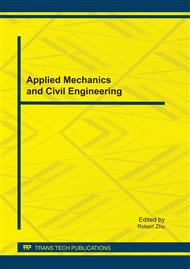p.210
p.215
p.221
p.227
p.232
p.237
p.243
p.250
p.256
Research on Numerical Analysis and Application of the Tailing Pond
Abstract:
Determining the location of infiltration ascender line is a key problem to analyze the 3-D seepage field of the tailing pond. As the location of infiltration ascender line is determined by the actual water edge, the calculation location of saturated surface is lower because of no considering the discharge of the mineral water or the flood. When the location is determined by the direct conversion of dry beach length which is suggested in the standards, the calculation location of saturated surface is higher than the measured value. To get the actual location of saturated surface, a new method is suggested to determine the location of infiltration ascender line, called “the indirect conversion method” in the paper. On the basis of the new method, the numerical simulation is carried out to analyze the 3-D seepage field, and the numerical results are compared with the testing results to prove the rationality of the new method.
Info:
Periodical:
Pages:
232-236
Citation:
Online since:
October 2011
Authors:
Keywords:
Price:
Сopyright:
© 2012 Trans Tech Publications Ltd. All Rights Reserved
Share:
Citation:


